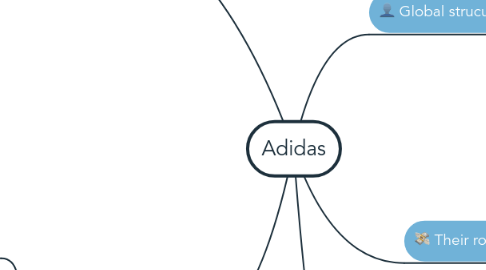
1. Social Impacts
1.1. Adidas equips 6000 olympic athletes from 33 countries. The Adidas athletes have won 220 medals including 70 gold medals.
1.2. Adidas employs 55.555 thousand workers. Roughly 3500 of them work in the Adidas headquarters.
1.3. Adidas collaborates with material suppliers, universities, scientific institutions and public figures like designer Stella Mccartney and famous rapper Kanye West.
1.4. They advertise a healthier and more active lifestyle that inspires people.
2. Environmental Impacts
2.1. Environmental strategy
2.1.1. Adidas developed an environmental strategy which reduced their relative environmental footprint by 15% in 2015.
2.1.2. Water conservation was helped by the use of drydye fabric which saved 100M litres of water in 2015.
2.1.3. They have launched eco-stores which systems' can produce energy savings of up to 50%.
2.1.4. The company also plans on phasing out plastic bags from its 2900 stores all around the world.
2.1.5. Green washing: "We are continuously working towards becoming a more sustainable company. While we have been in this game for a long time, we will never stop learning and improving our sustainability efforts. For us, it is about being prepared, setting the right pace and having both the drive and stamina to go the distance. It is about being persistent, overcoming setbacks and difficulties and never giving up on the overall goal. Just like a true athlete never would."
2.2. Pollution
2.2.1. In 2012, Greenpeace accused Adidas of contaminating water systems through chemical residues left on clothing sold to costumers worldwide.
2.2.2. "Our tests of the wastewater found toxic chemicals that have no place in our natural environment." - Greenpeace.
2.3. Sustainable inovations
2.3.1. Adidas created a shoe made almost entirely from ocean garbage and they're beautiful!! (ecologically beneficial shoe)http://www.runnersworld.com/running-shoes/adidas-unveils-shoe-created-from-ocean-plastic
3. Global strucure
3.1. Countries of production: 62 countries globally
3.1.1. 60% of the products are made in the Asia-Pacific region
3.1.2. 20% manufactured in the Americas
3.1.3. 17% in Africa and the Middle East.
3.2. Headquarters in Herzogenaurach, Germany, the home town of the founder of the company, Adolf Dassler.
3.3. Origin of the top 25 designers
3.3.1. 15 are German
3.3.2. 8 come from the US
3.3.3. The two others come from Canada and China
